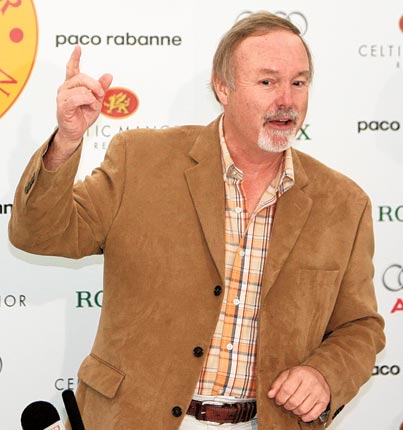Brian Viner: Lord of the Manor battling bureaucrats over a blot on the Ryder Cup landscape
The Last Word

Down at Celtic Manor, where a month from today the clearing-up operation is scheduled to begin in the wake of the 38th Ryder Cup, they have a standard answer for anyone who gazes open-mouthed at the derelict building right next to the swanky, purpose-built, Twenty Ten course clubhouse and wonders aloud how, with the eyes of the golfing world about to turn to the otherwise lovely Usk valley, such a ruin could possibly be permitted to remain in place.
"It's the American team room," they say.
This crack usually elicits a laugh, at least it did from me on my first visit to the course a few weeks ago, but it doesn't answer the question. However, a little bit of digging – not, alas, with a JCB – yields a strange and rather dispiriting story.
In a nutshell, it is this. The building in question, Little Bulmore farmhouse, is Grade II-listed. The owner of Celtic Manor, Sir Terry Matthews, offered to remove it brick by brick and erect it elsewhere on the estate, fully restoring it in the process. Newport council's planning committee said no, one of the councillors reportedly referring to the Ryder Cup as a "three-day circus," and not sufficient reason to tinker with the valley's heritage. A furious Matthews duly threatened to stop investing in the area, where he was born 67 years ago before emigrating to Canada and making his fortune in telecommunications.
Even those of us who do not instinctively rally to the banner of billionaires should take Matthews' side in this unseemly spat. By developing the resort in the first place, and now anointing it with the Ryder Cup, he has directed untold millions into a region of Britain that needs as much economic help as it can get. Of course, I also understand the other side of the argument, that a hugely wealthy man should not necessarily be allowed to flex his chequebook to get what he wants. But the politics of envy are at play here, and I sense that some of the Newport councillors have rather enjoyed playing David to Sir Terry's Goliath.
I confess, too, that I applauded when something similar happened in Scotland three years ago, choleric local farmer Michael Forbes stymieing, at least for a while, Donald Trump's plans to build a billion-pound golf resort in Aberdeenshire. From King Midas's time to this, there's always been an eager audience for stories of rich men thwarted. But Matthews should surely have been indulged in the case of the Little Bulmore farmhouse, which might be Grade II-listed, but is by any standards an eyesore.
This week I heard about the latest development in the saga: Newport council has magnanimously given its blessing for the nastiest part of the building, a modern breeze-block lean-to, to be removed. Whether Matthews considers this enough of a compromise to withdraw his threat of no more investment remains to be seen.
Whatever, the beleaguered European team captain Colin Montgomerie can at least take comfort in the knowledge that here is one Ryder Cup planning controversy that has nothing to do with him. As for his widely derided decision to leave out Paul Casey, and the upset it apparently caused the world No 9, I have further comfort for Monty, because two years ago Casey told me that he supported the assertion by none other than Jack Nicklaus that the Ryder Cup is a mere frippery compared with major championship golf.
"Every golf fan knows how many majors Nicklaus won," Casey said. "It's 18. But what's Jack's Ryder Cup record? Nobody knows. Faldo has the greatest points haul of any European golfer in the Ryder Cup, and Monty's just behind him, but I don't know what that number is. All I know is that Faldo won six majors."
Actually, I couldn't agree more. We all get far too hot under the collar about the Ryder Cup. But tell that to Sir Terry Matthews and the Newport councillors.
Professional approach must stop anarchy in the box
Something significant happened in a football match 20 years ago today between Manchester United and Luton Town. A United player, now the Sunderland manager, Steve Bruce, became the first footballer in the English game's top division to be shown a red card under Fifa's new "professional foul" rule.
Bruce has grown rather proud of his historical first, doubtless recognising the rule as a positive amendment to the laws of the game. And so it was. There were those who chuntered that the words "professional" and "foul" should never be bracketed together, but that was to ignore the realities of football. Unfortunately, like most rules, it has been rendered much less potent by the passing of time. A modern reality of the so-called Beautiful Game is the frenzied grabbing of shirts in the penalty area, prior to a corner or free-kick. The sooner this is interpreted as a clear professional foul, and punished accordingly, the better. At the moment, anarchy reigns and nobody seems willing or able to do anything about it.
Boundaries of meaning blurred
We refuse, here at The Last Word, to prejudge the wretched Pakistani cricketers accused of delivering no-balls to order. And we don't know whether the phrase "overstepping the mark" originated on the cricket field. But if guilty is the verdict, could its literal and metaphorical meanings ever be more closely entwined?

Join our commenting forum
Join thought-provoking conversations, follow other Independent readers and see their replies